Wingspan 16 m Introduced 29 February 1956 | Length 17 m First flight November 26, 1951 Number of seats 2 | |
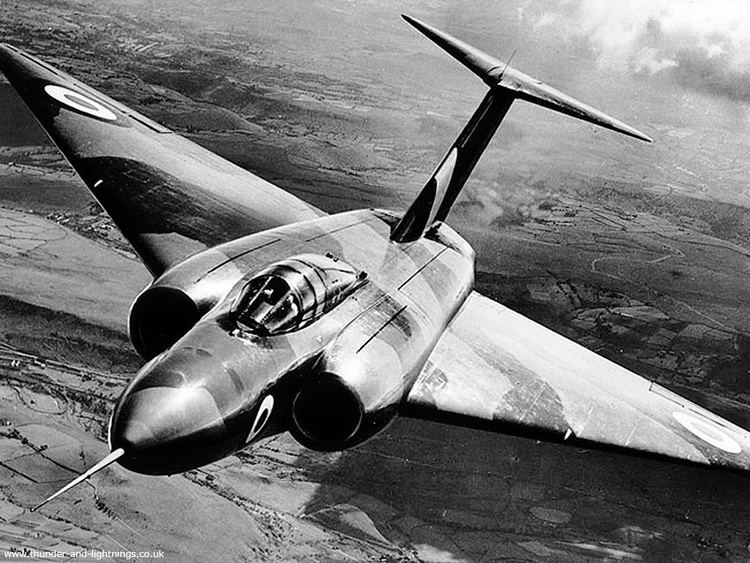 | ||
Engine type | ||
Mission 66 gloster javelin mission 1966
The Gloster Javelin is a twin-engined T-tailed delta-wing subsonic night and all-weather interceptor aircraft that served with Britain's Royal Air Force from the mid-1950s until the late 1960s. The last aircraft design to bear the Gloster name, it was introduced in 1956 after a lengthy development period and received several upgrades during its lifetime to its engines, radar and weapons, including support for the De Havilland Firestreak air-to-air missile.
Contents
- Mission 66 gloster javelin mission 1966
- Gloster javelin
- Origins
- Prototypes
- Production and further development
- Design
- Operational history
- Variants
- Operators
- Italy
- South Africa
- United Kingdom
- Specifications Gloster Javelin FAW Mk 9
- References
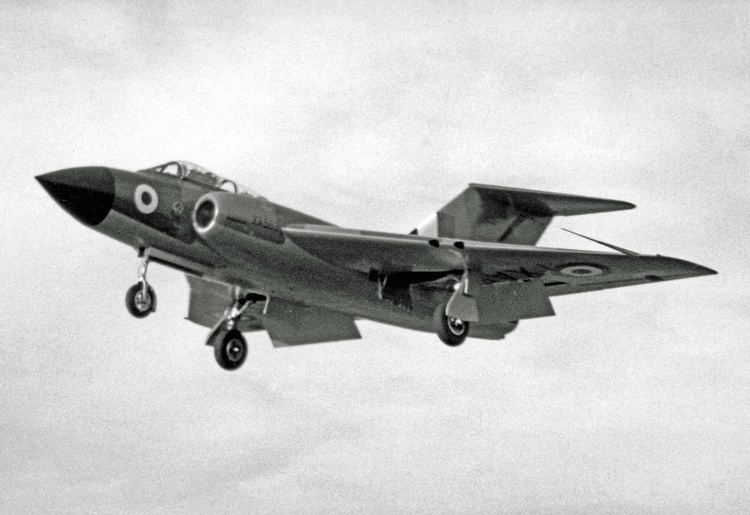
The Javelin was succeeded in the interceptor role by the English Electric Lightning, a supersonic aircraft capable of flying at more than double the Javelin's top speed, which was introduced into the RAF only a few years later. The Javelin served for much of its life alongside the Lightning; the last Javelins were withdrawn from operational service in 1968 following the introduction of successively more capable versions of the Lightning.
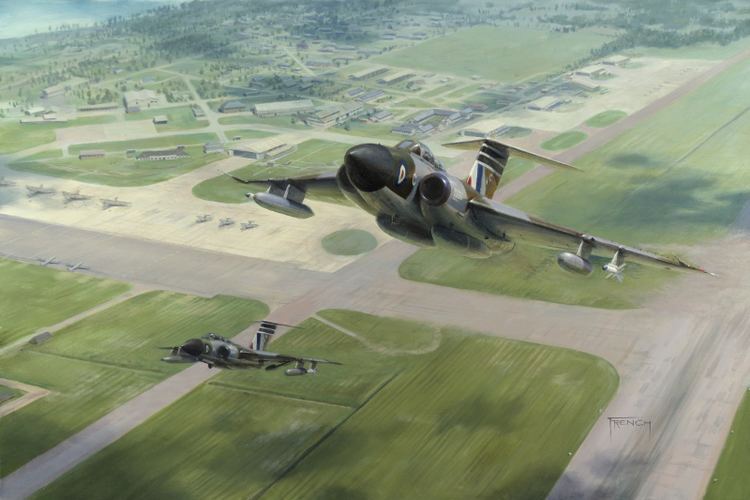
Gloster javelin
Origins
In the aftermath of the Second World War, Britain identified a threat posed by the jet-powered strategic bomber and atomic weaponry and thus placed a great emphasis on developing aerial supremacy through continuing to advance its fighter technology, even following the end of conflict. Gloster Aircraft, having developed and produced the only Allied jet aircraft to be operational during the war, the Gloster Meteor, sought to take advantage of its expertise and responded to a 1947 Air Ministry requirement for a high-performance night fighter under Air Ministry specification F.44/46. The specification called for a two-seat night fighter, that would intercept enemy aircraft at heights of up to at least 40,000 feet. It would also have to reach a maximum speed of no less than 525 kn at this height, be able to perform rapid ascents and attain an altitude of 45,000 feet within ten minutes of engine ignition.
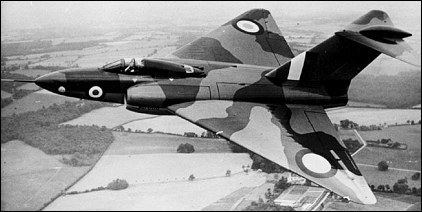
Additional criteria given in the requirement included a minimum flight endurance of two hours, a takeoff distance of 1,500 yards, structural strength to support up to 4g manoeuvres at high speed and for the aircraft to incorporate airborne interception radar, multi-channel VHF radio and various navigational aids. The aircraft would also be required to be economical to produce, at a rate of ten per month for an estimated total of 150 aircraft.
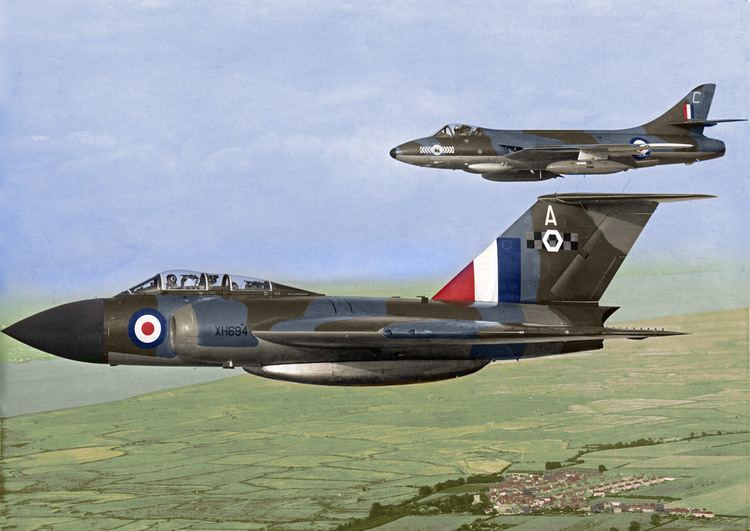
Gloster produced several design proposals in the hope of satisfying the requirement. P.228, drawn up in 1946, was essentially a two-seat Meteor with slightly swept wings. A similar design was also offered to the Royal Navy as the P.231. The later-issued P.234 and P.238 of early 1947 had adopted many of the features that would be distinctive of the Javelin, including the large delta wing and tailplane. The two differed primarily in role; P.234 was a single-seat day fighter with a V-tail, while P.238 was a two-seat night fighter with a mid-mounted delta tailplane.

The RAF requirements were subject to some changes, mainly in regards to radar equipment and armaments; Gloster also initiated some changes as further research was conducted into the aerodynamic properties of the new swept and delta wings, as well as use of the new Armstrong Siddeley Sapphire turbojet engine.
Prototypes
On 13 April 1949, the Ministry of Supply issued instructions to two aircraft manufacturers, Gloster and de Havilland, to each construct four airworthy prototypes of their competing designs to meet the requirement, as well as one airframe each for structural testing. These prototype aircraft were the Gloster GA.5, designed by Richard Walker, and the de Havilland DH.110, the latter of which held the advantage of also being under consideration for the Royal Navy. Development was considerably delayed through political cost-cutting measures, the number of prototypes being trimmed down to an unworkable level of two each before the decision was entirely reversed; this led to the unusual situation where the first production Javelin was actually completed prior to the prototype order being fulfilled.
The first prototype was structurally completed in 1951; one unusual feature of the prototypes was the opaque canopies over the two-man cockpits, it had been believed that visibility was unnecessary and a hindrance to the observer's role, the only external view available was via small 'portholes'. Following a month of ground testing, on 26 November 1951, the first prototype conducted its first flight at Moreton Valence airfield. Bill Waterton, Gloster's Chief Test Pilot, would later describe the Javelin as being "as easy to fly as an Anson"., although also expressing concern over its inadequate power controls. Disaster nearly struck during one test flight when aerodynamic flutter caused the elevator surfaces to detach in mid-flight; despite the lack of control surfaces, Bill Waterton was able to land the aircraft. He was awarded the George Medal for his actions to retrieve flight data from the burning aircraft.
The second prototype (WD808) received a modified wing in 1953. After initial testing by Waterton, it was passed to another Gloster test pilot, Peter Lawrence for his opinion. On 11 June 1953, the aircraft crashed during testing. Lawrence had ejected from the aircraft, but too late (at about 400 ft (120 m)), and was killed. The Javelin had experienced a "deep stall"; the wing acting like an airbrake had killed forward motion and at the same time stopped airflow over the elevators, leaving them useless. Without elevator control, Lawrence was unable to regain control and the aircraft dropped from the sky. A stall warning device was later developed and implemented for the Javelin.
The third prototype (WT827), and the first to be fitted with operational equipment including radar, first flew on 7 March 1953. The fourth WT827 was passed to the Aeroplane and Armament Experimental Establishment (A&AEE) for trials and the fifth prototype, WT836, made its first flight in July 1954. On 4 July 1954, a prototype Javelin accidentally achieved supersonic speed during a test flight, the pilot having been distracted by an oxygen supply failure.
Production and further development
The official production order for the Javelin was issued in mid-1953; as the Gloster Meteor was still being actively produced by Gloster, considerable elements of the Javelin were subcontracted out to other aviation companies owned by the Hawker Siddeley Group, such as Armstrong Whitworth. While some delays were incurred, the Javelin's status as a "super priority" for production helped to minimise the time involved in producing each aircraft. On 22 July 1954, XA544, the first production aircraft, took flight at Hucclecote. Production was assisted by a large order placed by the United States Air Force, purchasing aircraft for the RAF as part of the Mutual Defense Aid Program at a price of £36.8 million.
On 21 October 1954, a pilot attached to Gloster from RAE Farnborough was killed while flying Javelin XA546 after having entered what appeared to be an intentional spin. On 8 December 1955, a service test pilot S/L Dick was testing XA561 for the A&AEE when the aircraft entered a flat spin during manoeuvres, which the anti-spin parachute could not stop, and he ejected. Following this, a stall-warning device was developed for the Javelin.
By the end of 1956, the Javelin was up to a FAW 7 variant, which was the first to meet the specifications of the original Air Ministry requirement, and which was to become the definitive version of the aircraft (most of which were later altered to the FAW 9 standard). The Javelin was evolving so quickly that deliveries of the FAW 8 began before FAW 7 production had ended. As a result, the final 80 FAW 7 aircraft went straight from the factory into storage, eventually flying after being re-manufactured as FAW 9s. A total of 427 Javelins were produced in all variants, plus seven prototypes. While there had been considerable interest from several NATO air forces, there were no export orders for the Javelin.
Design
The Javelin was the RAF's first purpose-built all-weather interceptor aircraft. Aerodynamic features of the type included its adoption of the new delta wing and a large tailplane. Fuel and armaments were housed in the delta wing, while the engines and crew were contained within the fuselage. The delta wing and tailplane combination had been deemed necessary by Gloster for effective manoeuvrability at high speed and for the aircraft to be controllable at low landing speeds. In one instance during testing, when both elevators had been torn off by elevator flutter, the Javelin remained controllable in part due to the aerodynamic qualities of the large tailplane. Changes from the prototypes included alterations to the rear fuselage and lengthened engine jet exhausts, to eliminate buffeting of the rudder by the jet exhaust and increased sweepback of the wing's leading edge to improve high-speed handling.
The Javelin was reportedly easy to fly even on one engine. The flight controls were fully power-assisted and production aircraft adopted a hydraulic 'feel' system for the pilot. The Javelin featured an infinitely variable airbrake; the airbrake proved to be extremely responsive and effective, allowing pilots to conduct rapid descents and heavy braking manoeuvres, enabling equally rapid landings to be performed. The turnaround time between sorties was significantly shorter than with the preceding Gloster Meteor, due to improved ground accessibility and engine ignition sequence. Unlike the Meteor, the Javelin was fitted with ejector seats, at the introduction to service of the type.
In spite of the aircraft's unorthodox aerodynamic features, the Javelin had a fairly conventional structure and materials, being mainly composed of an aluminium alloy, with some use of steel edging. The fuselage was composed of four sections, the nose (containing the radar radome), the front fuselage, centre fuselage and rear fuselage; the nose and rear fuselage were removable for servicing and easy replacement. The engines were on either side of the centre fuselage section, the internal space in the centre containing the service bay that housed much of the aircraft's electrical, hydraulic, and avionics subsystems. The engine air intakes were placed on the forward fuselage, running directly from beneath the cockpit rearwards into the delta wing. Electricity was provided by a pair of 6,000 watt, 24-volt generators driven by the auxiliary gearbox; inverters provided AC power for equipment such as some flight instruments and the radar.
Operational history
The Javelin entered service with the RAF in 1956 with 46 Squadron based at RAF Odiham, England. The Javelins were immediately put to use in an intensive flying programme, to rapidly familiarise crews with the type. The introduction of the Javelin was eased by the establishment of a partial Operational Conversion Unit, a specialised team to assist the members of other squadrons in converting to the type. During RAF trials, the type proved readily capable of intercepting jet bombers such as the English Electric Canberra and modern jet fighters, over a hundred miles out to sea.
A second squadron, 141, would be equipped with the Javelin in 1957, replacing the squadron's de Havilland Venom aircraft. The introduction of the Javelin, allowed the RAF to expand its night-fighter activity considerably. By the end of July 1959, all remaining Meteor squadrons had been converted, many having been assigned to operate various models of the Javelin, including the newest FAW.7 variant.
The closest that the RAF's Javelins came to combat, was during the Malaysian Confrontation with Indonesia from September 1963 until August 1966. Javelins of 60 Squadron, later joined by 64 Squadron operated out of RAF Tengah, Singapore flying combat patrols over the jungles of Malaysia. In 1964, an Indonesian Air Force Lockheed C-130 Hercules crashed while trying to evade interception by a Javelin FAW.9 of 60 Squadron. During June 1967, following the disbandment of 64 Squadron, 60 Squadron was deployed to RAF Kai Tak, Hong Kong because of unrest in the colony during China's Great Proletarian Cultural Revolution. Javelins were also deployed to Zambia during the early stages of Rhodesia's Unilateral Declaration of Independence, to protect Zambia from any action by the Rhodesian Air Force.
The last of the type was withdrawn from service in 1968, with the disbandment of 60 Squadron at RAF Tengah at the end of April 1968. One aircraft remained flying with the Aeroplane and Armament Experimental Establishment at Boscombe Down until 24 January 1975.
Variants
A total of 435 airframes were built by Gloster and Armstrong-Whitworth; both companies at that time were part of the Hawker Siddeley group. Several were converted to different marks (sometimes repeatedly).
Several variants were proposed and investigated but not produced, including reconnaissance versions, a fighter bomber version with underwing panniers for bombs, and a supersonic variant with area-ruled fuselage, thinner wings, and a new tail. The "thin-wing Javelin" would have been capable of about Mach 1.6, with a higher ceiling than contemporary US designs. Initial work started with fitting a thinner-section wing to a Javelin fuselage but as the project developed the changes became so great that it would effectively have been a different aircraft albeit having an outward resemblance to the Javelin. The final incarnation of the thin-wing Javelin just before cancellation was a large aircraft carrying two Red Dean all-aspect missiles as a possible contender for Operational Requirement F.155.
Operators
Italy
South Africa
United Kingdom
Specifications (Gloster Javelin FAW Mk 9)
Data from Profile: Number 179
General characteristics
Performance
Armament
Avionics
